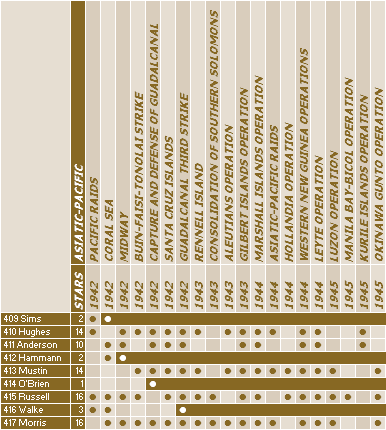
The Naval Historical Foundation’s 2002 book “Destroyer Squadron Two: from Leyte Gulf to Okinawa” describes the squadron’s early history. In 1940, under Captain Walden L. (“Pug”) Ainsworth in flagships Moffett and Somers, it included a changing mix of the latest Benham- and Sims-class destroyers joining the fleet. Squadron composition stabilized the next year when nine 1570-tonners became available: Sims (DD 409), Hughes (DD 410), Anderson (DD 411), Hammann (DD 412), Mustin (DD 413), Russell (DD 414), O’Brien (DD 415) and Walke (DD 416) with Morris (DD 417) as Ainsworth’s new flagship.
World War II Operations of the destroyers
originally attached to Destroyer Squadron 2
Operating in the North Atlantic neutrality patrol before the United States entered World War II, DesRon 2 ships formed the screen of Yorktown’s Task Force 17, departing Norfolk for the Pacific in December. In 1942, the squadron continued in carrier escort duty with individual ships participating in the Battles of the Coral Sea (where Sims was lost), of Midway (where Hammann was lost), the torpedoing of Wasp (where O’Brien was lost), the Battle of the Santa Cruz Islands and the final Battle of Guadalcanal, 14–15 November 1942 (where Walke was lost). Thus, one or more of them were present at the sinking of all four US carriers lost in 1943, but the squadron was reduced to five ships, Morris, Anderson, Hughes, Mustin and Russell.
Since before the war, the first two ships of the ten-ship Benham class had been operating in the Pacific, attached to DesRon 6. Of these, Benham was lost in the same action as Walke but, after a west coast overhaul in late 1943, Ellet joined DesRon 2 on her return to the war zone, bringing squadron strength back to six ships.









Sims, Hughes, Anderson, Hammann, Mustin, Russell, O’Brien, Walke and Morris, the first nine ships of the Sims class, which composed DesRon 2 when the United States entered World War II.
Meanwhile, DesDiv 15—Benham-class Lang, Stack, Sterett and Wilson—had operated in the Atlantic and Mediterranean with Wasp (CV 7) and, in June 1942, escorted her to the Pacific. Wilson was engaged at the Battle of Savo Island immediately following the Guadalcanal landings and Sterett participated in the Battle of Guadalcanal in November, for which she was awarded the Presidential Unit Citation.
In the summer of 1943, while DesRon 2 was dispersed with Hughes, Mustin and Morris operating in the Aleutian Islands, DesDiv 15—less Wilson—under Commodore Simpson, formed Support Division “A-2” in Cmdr. Frederick Moosbrugger’s victory at the Battle of Vella Gulf.





Ellet, Lang, Stack, Sterett and Wilson—the Benham-class ships that joined DesRon 2 late in World War II.
In 1944, the five Sims-class veterans were combined into DesDiv 3 of DesRon 2 while the veteran DesDiv 15 was reassigned as DesDiv 4.
In 1943 and 1944 respectively, Roe and Wainwright were also transferred to the squadron from the Mediterranean Sea where they, like Buck (the 12th and last ship of the Sims class, lost in the Mediterranean), had served as squadron flagships. Although assigned to DesRon 2 in 1945, these two ships never operated with it.
From late 1943, DesRon 2 participated in the Gilberts and Marshalls operations, where Anderson was hit by shore battery fire. This was followed by the invasions of the Marianas, western New Guinea, Palau and the Philippines and, in 1945, Okinawa, where Anderson, Hughes, Morris, Sterett and Wilson suffered kamikaze damage*. The flagship was repaired only as needed to make the voyage home; the others survived.
The combined record of the ships of DesRon 2 included 145 battle stars (some earned while attached to other units)—including 10 or more stars for all ships that survived the war—at a cost of more than 450 killed and 175 wounded.
After the war, Lang, Sterett, Russell, Morris and Roe were sold for scrap while Stack, Wilson, Hughes, Anderson, Mustin and Wainwright were used as targets for the Bikini atomic tests. There, while Anderson was sunk in Test Able on 1 July 1946, Stack, Wilson, Mustin, Hughes and Wainwright survived both Tests Able and Baker. Contaminated, the five were monitored by scientists until 1948, when they were sunk by gunfire—Stack, Wilson, Mustin and Wainwright off Kwajalein in April and July, and Hughes—the last surviving ship of the squadron—near California’s Farallon Islands in October.
* Source: RAdm. Robert H. Spiro, Jr., Morris Supply Officer, 1943–45. writing in Destroyer Squadron Two, from Leyte Gulf to Okinawa, a Commemoration of DesRon 2’s Battle with Suicide Attackers, October 1944–May 1945, Washington, Naval Historical Foundation, 2002.